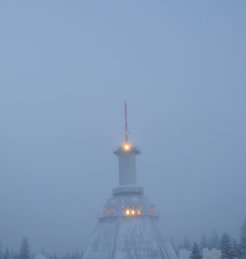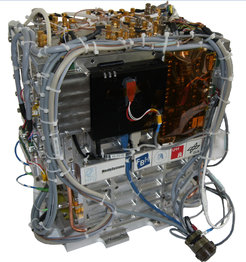Space revisited – second flight of FOKUS comb
One more time … Second frequency comb space flight with upgraded system.
FOKUS & KALEXUS: a space based comparison of three different atomic clocks

TEXUS rocket launch from ESRANGE figure courtesy of Airbus D&S
After its inaugural flight in April 2015 (http://www.menlosystems.com/events/news-press-releases/view/2300), the FOKUS experiment was upgraded and requalified for its second flight: In its extended configuration (FOKUS Ib) it now conducted a comparison of three clock frequencies generated by different atomic precision spectroscopy methods. Two optical clocks, relying on Rubidium and Potassium atoms and one radio frequency clock based on Rubidium atoms were compared by the optical frequency comb, while the payload traveled through the changing earth gravitational field.
One of the optical references is generated by a Rb spectroscopy stabilized distributed feedback (DFB) laser situated in the FOKUS module. This module has been redesigned for this flight and now incorporates a modulation transfer spectroscopy scheme, giving access to higher clock stability and accuracy compared to the prior flight. The second optical signal was generated by a potassium stabilized extended cavity diode laser (ECDL) within the autonomous KALEXUS experiment module. Both reference payloads have been developed within national consortia led by Humboldt-University of Berlin. Also the radio frequency clock was upgraded for this second flight opportunity to offer a higher precision.
Space based clock comparisons – a challenge for fundamental physics
This clock comparison is a prototype experiment for possible satellite based tests of fundamental physics: In future experiments, a space grade optical frequency comb will enable precision clock comparisons between state of the art space optical clocks. Such a space-based clock comparison with unprecedented sensitivity is testing Einstein’s general theory of relativity (the local position invariance) that predicts that gravity has the same influence on all clocks no matter how the clock is realized. Eventually such experiments will lead to new theories of gravity and will completely change our understanding of the world.
As a prototype experiment FOKUS and KALEXUS bring such space clock based fundamental physics tests in reach, paving the way for future satellite missions.
Optical frequency combs – ready for more
This second flight again demonstrates the robustness and high technology readiness level of Menlo’s frequency combs, enabling future comb applications in space as well as in other harsh environments:
The payload and the comb experienced vibrations up to 8g rms, shocks of up to 15g and constant accelerations up to 13g. Nevertheless, the fully automated comb performed its scientific experiment successfully and stayed operational before, during and after the flight – one more time.

FOKUS comb and Rb laser module
The FOKUS experiment is a collaborative effort between Menlo Systems, the Max-Planck-Institute of Quantum Optics, Garching, the Ferdinand Braun Institute, Berlin, Humboldt University, Berlin, the University of Hamburg and the Johannes Gutenberg University, Mainz
We thank all project partners as well as the TEXUS teams from DLR-MORABA, Airbus D&S and OHB Systems AG and DLR Space Administration for this great effort and the exciting flight opportunity.
The FOKUS and KALEXUS projects are commissioned by DLR with funds from the Federal Ministry of Economics and Technology (BMWi) according to a decision of the German Federal Parliament. Christian Deutsch, Menlo Systems GmbH













